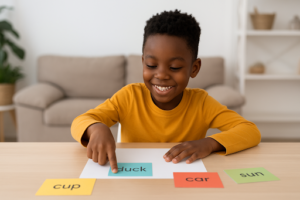If in the middle of applied behavior analysis, which was going very well, and then all of a sudden the progress dies down, or even comes to a stop, it is very disturbing. You may question what is going on, if anything went wrong, or if the therapy is still effective.
The fact is this is a very common issue which most families deal with and it does not mean your child has stopped growing. What you may be seeing is an ABA therapy progress plateau which is a natural break that can occur at any point in the development.
In a lot of ways plateaus are a type of stop along a long trip in the life of a child. They present a chance for your child’s mind and body to step back and process what they have learned before moving on to the next challenge. With the right ABA therapy approaches and close monitoring of progress a plateau can actually be what sets the stage for even greater success to come.
Why ABA Progress Sometimes Slows Down
Before we get into what to do, it is helpful to know what a plateau is and what it is not. In a center based setting, autism therapy progress is seen in small steady steps forward. But at times you may see that a skill which your child has been improving all of a sudden stops at the same level for weeks. That’s what is called an ABA therapy progress plateau.
It is different in that we see a child lose a skill they have already mastered. A plateau is just a level spot like stopping at a ledge before you go up. Also in many cases what we are seeing is the brain’s way of going over what it has already learned.
Common reasons include:
- Reinforcement changes: what used to work may not anymore.
- Generalization issues: a skill may perform well in one environment but not in others.
- Task difficulty: the next step in the program might be too big a leap.
- Environmental factors: changes at home, school, or in the therapy room can affect focus.
The positive news is that plateaus are not a sign that therapy isn’t working, they are simply indicating it’s time to change things up. With the right ABA therapy interventions and open lines of communication between parents and the therapy team, these plateaus can turn into breakthroughs which in turn will improve ABA therapy results in the weeks to come.
How To Identify And Interpret A Plateau
When in ABA therapy you see progress challenges present itself the first thing to do is to identify what is really going on. It is easy to get down if you are looking at only a few recent sessions but in center based ABA therapy progress is best seen over time. This is the area where consistent progress monitoring of ABA therapy becomes key.
Instead of focusing on daily ups and downs, your child’s team will review data from multiple sessions to see if skills have truly stalled, such as:
- Trends in accuracy and independence.
- Notes about behavior, mood, and motivation.
- The health of each program’s performance.

Your role as a parent and primary care provider is very important here. You are in the best position to notice changes which may be going on outside of the therapy setting, sleep patterns, diet, school transitions, growth spurts, even that which may be very subtle like a shift in mood that may play a role in ABA therapy progress. Reporting in on these details will help determine what may be causing a plateau in progress.
Practical Strategies for Breaking Through in ABA Therapy
Quick Triage Checklist: First Outcomes to Review
When in center based ABA therapy a child hits a plateau beginning with the easiest checks out before making large scale changes.
- Reinforcement Quality: Is the reward still motivating? Interests change quickly, so it’s worth doing a new preference assessment.
- Teaching Approach: Sometimes the mix of discrete trial training (DTT) and natural environment teaching (NET) needs adjusting.
- Task Difficulty: If a goal leap was too big, break it into smaller steps using shaping.
- Generalization Opportunities: Is the skill being practiced with different people and in different places?
- Environmental Factors: Noise, visual distractions, or changes in routine can all impact focus and performance.
Proven ABA Therapy Approaches to Reignite Progress
Once you have covered the basics we present to you a set of focused ABA therapy interventions which research and clinical practice has found to be effective:
- Outfit your system with a variety of rewards which include a mix of tangible and social.
- Break goals down into micro steps which help see quick success.
- Include playful NET breaks in which to move around and keep the energy high.
- Go back to a higher prompt level a bit to rebuild confidence, then bring it back down.
- Short term solutions can offer better results from shorter, more frequent sessions.
- Fine tuning data collection makes certain that data is clean and that it accurately represents progress, at times the issue is in the data, not the skill.
Home Routines That Are Good For Parents
Parents have a lot to do with problems that come up in ABA training. Here is a three part home transfer approach:
- One Skill: Focus on a single target your therapist recommends.
- One Prompt: Use the same prompt every time for consistency
- One Reinforcer: Keep the reward predictable so your child knows exactly what to expect.
When You Need To Make Bigger Changes
Small changes alone might not be enough to make progress, so your team might suggest that:
- Going through a new FBA to look at the role of a behavior again.
- You can move your child from home-based care to therapeutic programs or back again depending on what is best for them right now.
- Speech and occupational therapists should be on the team to help with communication and sensory problems.
We don’t want to start from scratch. Instead, we want to change what we do in treatment so that it is always interesting, doable, and helpful. What may seem like plateaus are actually just short detours on your child’s journey, not road blocks, if you keep an eye on their growth and work with the ABA therapist.

Parents at a plateau can go to an ABA therapy center
Try some new things when you notice that your child’s growth in ABA therapy at the treatment center has slowed down. This might help them make some progress again. These ABA therapy center tips are meant to help make the link between what is done at home and maketreatment stronger. As we all know, consistency is the most powerful tool we have.
- Get there a few minutes early: Your child will have a few extra minutes before the session to get settled in and get used to the room.
- Take a look at the day: You should go over the daily plan with your child if the therapist team gives it to you. Getting used to something makes you less anxious, which makes learning easier.
- Bring your best thing with you: When you reach a growth plateau in ABA therapy, it can be difficult to keep the child motivated. A favorite toy or snack can help during transitions and in general.
- Ask for short reports every week: You will see alignment even in a 10-minute session with your BCBA or therapist, which will make it easier to track your growth in ABA therapy.
- Have a party at home for the little wins: When you get a small win, you should notice it right away. Positive feedback isn’t just useful in therapy; it’s useful in every part of life.
Willow Reach ABA: Support Tailored to Your Child’s Needs
It’s best for all of the kids if treatment is safe, helpful, and fun. Willow Reach ABA knows that kids do well when they have set routines, can interact with their peers, and can use a lot of different tools. At home, treatment is done in a place that feels like home, which lowers stress and makes it easier to use new skills in everyday life. Everyone on the Willow Reach ABA team works with each family to make a care plan that we think will work best for them.
We take a proactive method to managing the growth of center-based ABA therapy. Through continuous ABA treatment progress monitoring, problems with plateaus are found early on. These are then fixed by changing goals, reinforcement systems, and teaching methods as needed. We also work together with families on this, so the changes are really a team effort and can be used and supported at home.
So that ABA treatment works better and kids and their families are less stressed at the same time.
Final Thoughts
It’s not a dead end when you reach a progress plateau in ABA treatment; it’s a sign. There are times when this means your child is learning new things and times when it means you need to try something different.
In center-based ABA treatment, these breaks are normal. With the right ABA therapy techniques and ongoing progress monitoring, which is part of the process, progress can start up again and even get better.
As parents, therapists, and kids work together to adapt, support, and enjoy each step forward, the base works as a unit. People can reach plateaus with patience, innovation, and the right kind of help. These points can then be used to start long-term growth and success.
Frequently Asked Questions About ABA Therapy Progress
- How do I know if my child’s plateau is normal or if their ABA program needs a bigger change?
Most plateaus move on. If the problem doesn’t get better after a few weeks of small changes, you should talk to your BCBA about it and get a new plan.
- Can changing the time of day for therapy help with progress?
Yes. There are kids who do better in the morning and kids who do better in the afternoon. We can see how changing the time of classes might make people more interested.
- Is it okay to introduce new skills during a plateau?
There are times when it is appropriate, like when a brand-new, interesting skill is being taught. Your BCBA might give you ideas on when to bring new things to your child without making them too excited.
- Does Willow Reach offer blended home and center based ABA therapy?
Yes. Willow Reach will set up lessons at home and in a center, so kids can experience what each has to offer.
- How does Willow Reach keep parents involved in progress monitoring?
Parents regularly get reports, we also give them summaries of the data, and we ask them to join planning sessions. This puts them in charge of all decisions that affect their child’s progress.
Found this insightful? Follow Willow Reach ABA on Instagram and Facebook to get daily tips, success stories, and ideas on how to help your child improve.
